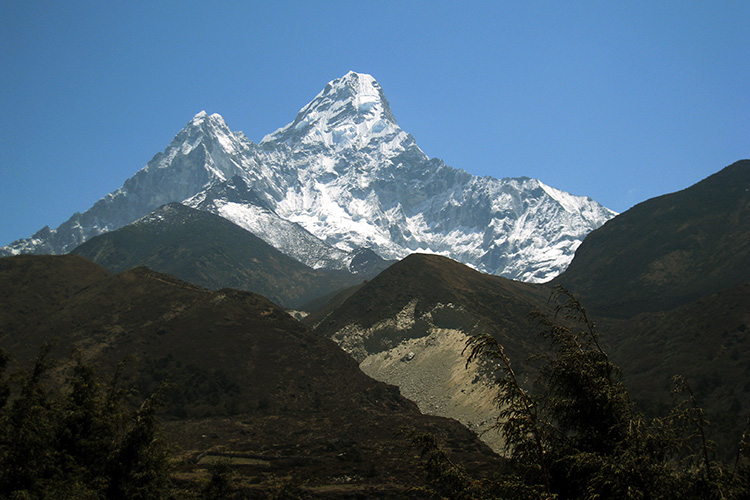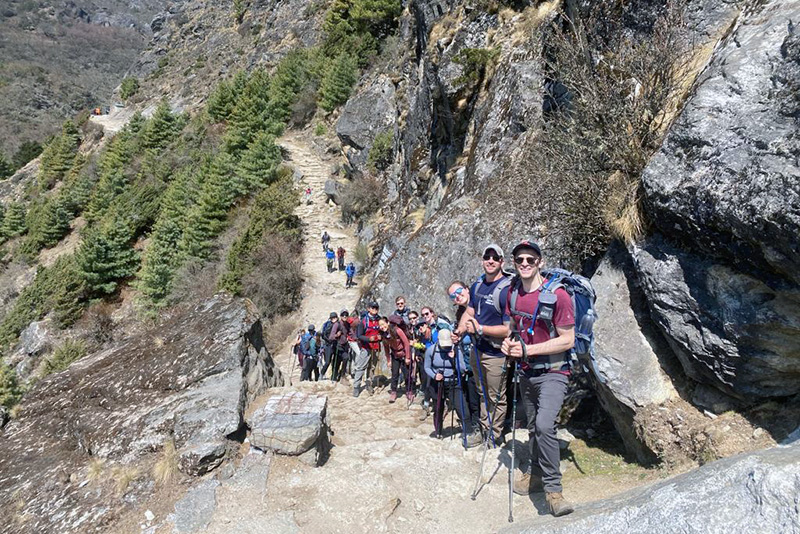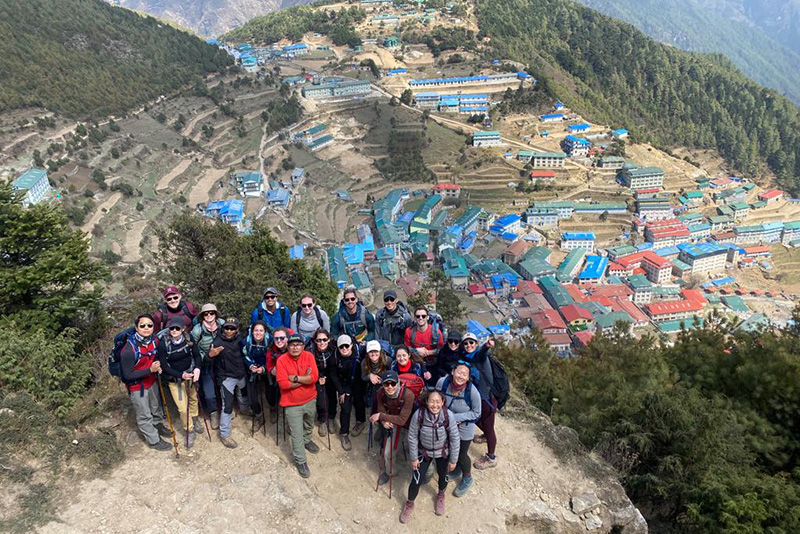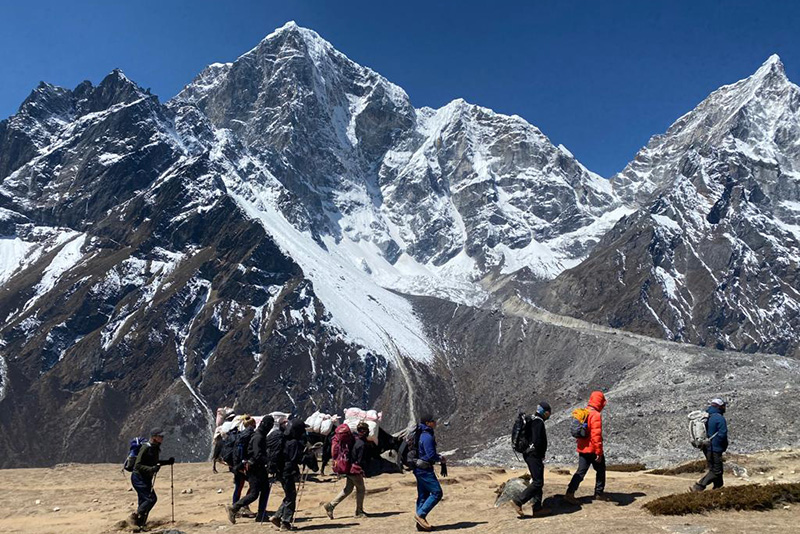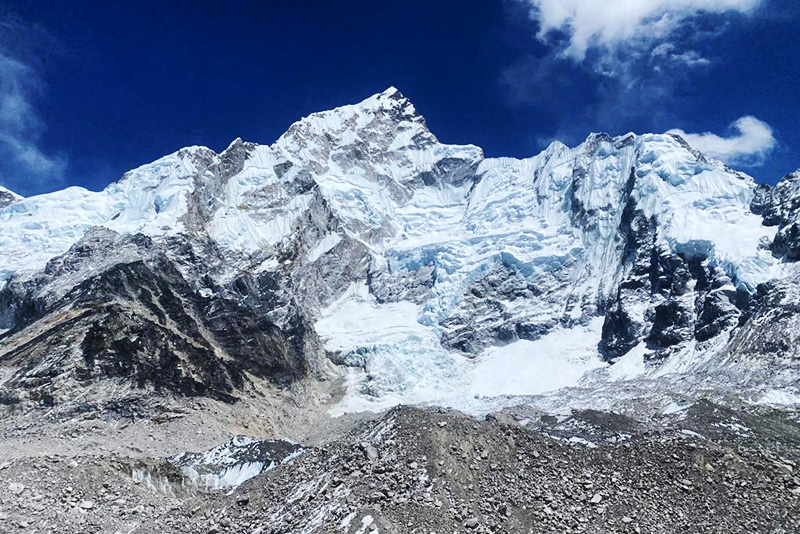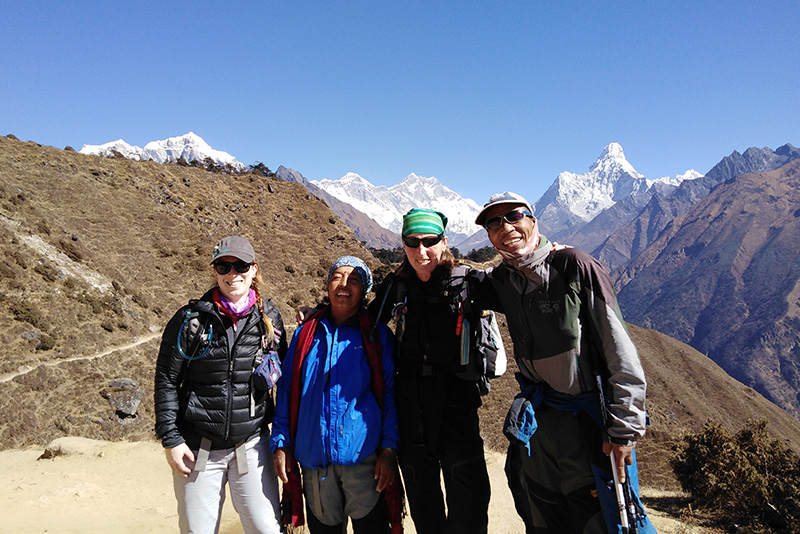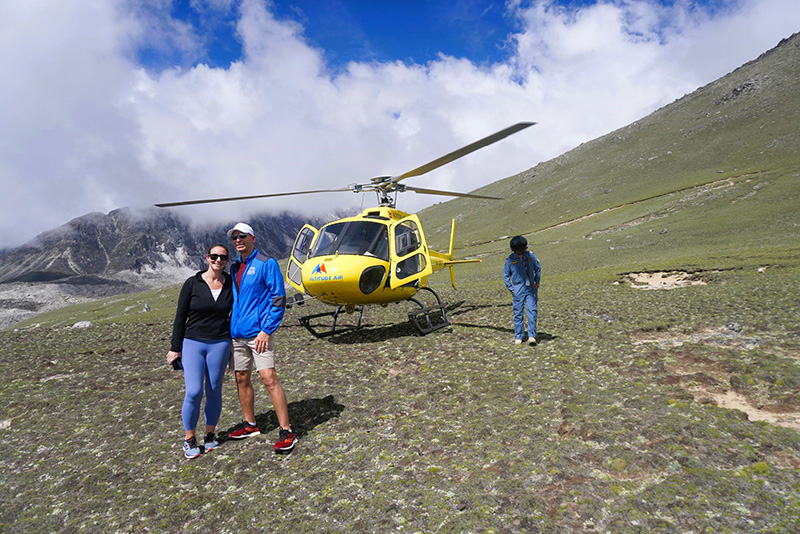The most appropriate response to the question of when to visit Everest Base Camp would be, "Whenever you feel prepared." The region of Everest presents something distinct and exceptional throughout every month of the year. Instead of sticking to the typical March-April and October-November timeframe that only highlights mountain views, we want to take you on a journey through a full year in the Everest Region and showcase all that it has to offer.
“Mountains are the beginning and the end of all natural scenery.”
By John Ruskin
Everest Base Camp Trek in January/February (Winter)
The Mount Everest Region during January and February is a great option for trekkers who are willing to endure the cold weather in exchange for breathtaking mountain views and less crowded trails.
January and February are not popular months for trekking in the Everest Region, with only approximately 7% of trekkers choosing to visit during this time. Although you won't be completely alone, you'll likely have the trail mostly to yourself.
Winter presents a great opportunity to observe magnificent wildlife such as the Himalayan Tahr, Snow Leopard, Himalayan Monal, and Musk Deer in their natural habitats. During the winter, many of these male animals migrate to the valleys or nearby human settlements. Therefore, there is a greater probability that your paths will intersect. Furthermore, the mountain view is exceptional and the Gokyo Lakes are currently frozen.
One of the cultural attractions to look out for is the Sherpa New Year, also known as Gyalpo Losar, which typically occurs towards the end of February.
The weather at 4,000 meters can be quite cold with nighttime temperatures dropping as low as -20 degrees Celsius. However, during the day, the temperature is generally tolerable. The skies are generally clear, except for a few days when snow is expected. Although clear skies offer stunning mountain views, it's important to be aware that when combined with snow cover, they can intensify UV exposure.
Planning Tips: When planning for snowy weather, it's important to consider appropriate footwear such as waterproof boots to navigate through slush. Additionally, it's recommended to dress in warm layers to accommodate for fluctuations in temperature. A good quality down jacket can be particularly helpful in this regard. High altitude passes are feasible, but it is important to be ready for encountering deep snow in certain areas. Crampons can be very useful. It is important to ensure that you have a good pair of sunglasses and sunscreen, as the level of UV exposure will be high. The flights are operating on a regular basis, however, it should be noted that not all lodges are currently open. It is advisable to contact them beforehand. However, it is unlikely that all of the lodges will be closed.
Everest Base Camp Trek in March/April (Spring)
This season provides a diverse range of experiences, including stunning mountain views, pleasant warm weather, beautiful blooming flowers, bustling crowds, and a touch of everything in between.
The months of March and April are the second most popular time of the year for the Everest Base Camp Trek. Approximately 25% of all trekkers choose to embark on this journey during this time, making their way to the highest base camp on earth. In April, there is a lot of activity at Everest Base Camp, which is a tented city. This is because April and May are the preferred months for an Everest Summit.
March and April are the months of rejuvenation, when nature's attractions come to life. As the snow melts away, rhododendrons begin to emerge from their dormant state at lower altitudes. As the sun rises, the primroses and irises higher up begin to reach upwards towards the sky. As the flowers bloom, a number of smaller birds that had migrated to the lowlands for the winter are slowly returning to their natural habitats. By mid-April, the spring air is abuzz with a flurry of wildlife activity.
It is highly likely that Buddha Jayanti, which celebrates the birth of Lord Buddha, will occur towards the end of April. This event is a significant cultural attraction. If you happen to be near a monastery on this day, it is recommended that you visit to partake in the solemn celebrations. The Sherpas are currently getting ready for a new agricultural cycle. The walls have been repaired, compost has been heaped, and the ground has been readied for planting.
In terms of weather, March is only slightly warmer than January and February. However, it's important to note that temperatures can still plummet to as low as -20 degrees Celsius at an altitude of 4,000 meters. In contrast to the previous months, April brings warmer temperatures to Namche. The mercury begins to rise above 0 degrees Celsius. As the temperature rises in the upcoming months, we can expect to see more rainfall, along with occasional thunderstorms and hailstones. Although, the weather is typically pleasant and the scenic views of the mountains are spectacular.
Planning Tips: It is important to remember to pack rainwear and warm layers. Investing in a high-quality waterproof boot can prove to be extremely beneficial, especially when you have to navigate through wet and muddy terrain. There is a possibility of flight disruptions at Lukla, although it is unlikely. It is advisable to plan with a delay of one or two days in mind.
Everest Base Camp Trek in May/June (Summer)
This is the perfect time for those who love mountaineering, running marathons, and exploring the outdoors like Mowgli. This could be the best time for the Everest Base Camp if there were no flight disruptions. It is advisable to enter and exit at Salleri during this time to avoid any potential risks.
The popularity of trekking in the Everest Region is still largely reliant on flights to Lukla. As a result, the months of May and June are not yet a popular choice, with only approximately 10% of trekkers visiting during this time.
The period is characterized by exceptional natural attractions due to the high level of biodiversity. Period. May and June are likely to be a delightful time for rhododendron enthusiasts, with a variety of colors and sizes available to admire, including red, blue, yellow, small, and large varieties. The clamor created by the cuckoos and barbets is currently at its highest point. Redstarts, laughing thrushes, and nutcrackers are actively displaying their territories and defending them. Overall, there is no better time for nature lovers to visit the Everest Base Camp.
May/June is a period filled with cultural attractions and events. Buddha Jayanti is celebrated in early May. In May, the Everest Base Camp is bustling with activity as mountaineers attempt to summit Everest. Everest Day is celebrated on May 29th to honor the first successful climb to the highest point on earth. On the same day, the Tenzing-Hillary Everest Marathon takes place, where hundreds of marathoners brave the challenging terrain from Everest Base Camp to Namche. In early June, the vibrant Mani Rimdu festival will take place in Thame, which is just around the corner.
Regarding the temperature, it is currently at its best. During this period, there is a noticeable increase in precipitation. Although the mornings begin with clear and pleasant weather, it gradually becomes cloudier throughout the day, typically resulting in rain or snowfall by the end of the day. Although the days may be overcast, it is important to consider UV exposure.
Planning Tip: It is important to wear sunglasses, even on overcast days, particularly at higher altitudes and when there is snow. If you are planning to take a flight to Lukla, it is advisable to plan flexibly. Alternatively, it would be advantageous to enter and exit from Salleri, which is only a two-day walk from Phakding.
Everest Base Camp Trek in July/August (Monsoon)
Trekking to Everest Base Camp during the months of July and August, which coincide with the monsoon season. This trek is recommended only for experienced trekkers who are willing to endure the harsh weather conditions in order to have an authentic cultural experience and witness the beautiful high altitude flowers.
This period is the least popular among trekkers, with only 3% of the annual Khumbu trekker population visiting during this time. The natural attractions in the Everest Region are breathtaking. Even the alpine pastures are currently adorned with a plethora of vibrant flowers, creating a stunning green landscape.
Cultural Attractions: The Sherpa villages celebrate the Dumji festival as the trekking season and agricultural season come to an end, allowing them to finally relax and enjoy the festivities. Moreover, considering that the local residents are not occupied at the moment, you could potentially engage in significant and profound discussions with them.
The rumors about the weather are true. During the monsoon season, it often rains heavily. Nonetheless, there is a positive aspect to the situation. The rainshadow effect that occurs after Namche reduces the intensity of the monsoon, and typically, mornings are dry. However, it is not advisable to rely on good visibility.
Planning Tip: it is advisable not to rely solely on flights. Period. If you plan to walk from Jiri or Salleri, be prepared to encounter leeches. To date, there have been no reported injuries caused by these harmless creatures. If you are not comfortable with donating blood, it may be helpful to carry some salt, alum, iodine, or anti-leech oil. Fortunately, there is a silver lining to the situation. Once you surpass the 3,000 meter mark, the number of leeches in the area begins to decrease. By the time you reach an altitude of 3,500 meters, you can be confident that you have left leech country behind.
Everest Base Camp Trek in September/October (Fall/Autumn)
This time of year is very popular and the trails are extremely crowded. The mountain views are truly remarkable and worth mentioning.
The popularity of this period is undeniable, as it attracts a significant number of trekkers, with a staggering 32% of them choosing to make their way to Everest Base Camp during this time.
The natural attractions are stunning, particularly the breathtaking mountain views. Although some flowers will still be visible until September, there will be a scarcity of them in October. Although the bird activity has significantly decreased, you can still observe many of them swiftly flying around. However, by the end of October, many birds begin their annual migration southward.
One of the cultural attractions in the Tengboche region is the Mani Rimdu festival, which typically takes place in late October.
The weather during this period is pleasant with temperatures hovering around 10°C at Namche (3,440m). However, the temperature can drop to around 0°C at night. By late October, temperatures can drop as low as -10°C at higher elevations such as Lobuche (4,940m). Regarding precipitation, September experiences a considerable amount, whereas October is typically characterized by low levels of rainfall. The visibility is exceptional due to the recent clearing of the atmosphere by the monsoon rains. Please note that post-monsoon disturbances are becoming stronger and may result in a period of heavy rainfall, even in October.
If you're planning to visit the Everest Region during a specific period, it's important to book your flights and lodges well in advance. This is the time when the accommodation facilities at Everest are at their maximum capacity. Therefore, it is advisable to book your reservations and double-check them if you are traveling on your own. It will be particularly significant if you intend to synchronize your trek with the Mani Rimdu festival at Tengboche.
Everest Base Camp Trek in November/December (Pre-Winter)
The months of November and December are a popular time for trekkers to visit the Everest Base Camp, with approximately 22% of visitors choosing to make the journey during this time.
In the Everest Region, December is the driest month of the year, making it an ideal time to explore the area's natural attractions. Therefore, the views of the mountains are magnificent. Many of the small birds that breed at high altitudes have either descended or are currently migrating. It is becoming increasingly easier to spot large wildlife such as Himalayan Tahr and Himalayan Monal as they are descending to the lower valleys of Everest.
One of the most vibrant cultural attractions in the Everest Region is the Mani Rimdu festival, which takes place in Tengboche during the early part of November. If you happen to be in the neighborhood at that time, this is an event that you won't want to miss.
The temperature is cold, but still tolerable. It is important to pack warm layers. During this season, the lack of precipitation results in clear skies. This implies that there are beautiful mountain vistas but also a high level of UV radiation.
Here are some planning tips: You shouldn't have any issues with flight disruptions or finding available lodging. Remember to pack sunscreen and sunglasses to protect yourself from UV radiation.
